Physical Address
304 North Cardinal St.
Dorchester Center, MA 02124
The bone marrow, the primary site of hematopoiesis, may contain hematopoietic or non-hematopoietic tumors and also frequently reflects metabolic disturbances. The occurrence of bone marrow metastases is strongly influenced by microenvironmental factors that favor the engraftment of certain malignancies. Bone marrow involvement by metastatic tumor is often referred to as myelopthisis and presents in the blood, usually subtly, as microangiopathic leukoerythroblastic anemia ( Fig. 58-1 ). Symptoms relate to cytopenias, metabolic disturbances, and occupation of space (such as bone pain), and may mimic leukemias and lymphomas. Imaging studies are often helpful, but a bone marrow examination is usually required to directly visualize the process. Bone marrow examination should include both aspiration and biopsy, and multiple sites (usually bilateral iliac crest) may need sampling.
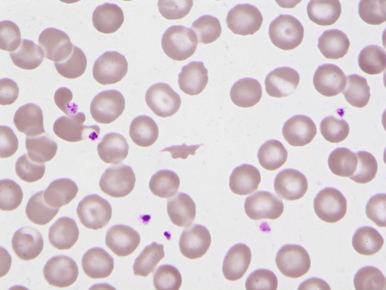
Serum chemistry is often abnormal in metastatic disease and also in metabolic disease simulating metastasis. Elevated calcium, uric acid, blood urea nitrogen (BUN), and/or lactate dehydrogenase (LDH) with thrombocytopenia reflect metastasis, and elevations of LDH and serum glutamic oxaloacetic transaminase (SGOT) occur in bone marrow necrosis.
The most common metastatic tumors are carcinoma of the breast, lung, and prostate, together constituting two thirds of cases. Each of these is present in up to 20% of patients with the primary tumor. Other metastases seen at lower frequency are adenocarcinoma of the stomach and colon, melanoma, renal cell carcinoma, ovarian and testicular carcinoma, transitional cell carcinoma, rhabdomyosarcoma, Ewing's sarcoma, vascular tumors, and, occasionally, many others. Childhood tumors frequently involving the bone marrow are rhabdomyosarcoma, neuroblastoma, retinoblastoma, medulloblastoma, and Ewing's sarcoma. Metastatic tumors are best diagnosed and classified from their primary site, however, immunohistochemistry provides an adjunct to morphology for those of which the primary site is not known ( Table 58-1 ).
| Tumor Type | CK8 and CK18 (CAM5.2 and 35βH11), Pan-Keratin (AE1, AE3) CK19 | CK7 | CK20 | CK5, CK6 | EMA | CEA | p63 | TTF-1 | CDX2 | PSA, PSAP | Villin | GCDFP-5, Mammaglobulin | Synaptophysin, CD56, NSE | NB84 | HMB45, MART-1 | Desmin | Myogenin, Myo-D1 | CD99 | FLI-1 | CD117 |
|---|---|---|---|---|---|---|---|---|---|---|---|---|---|---|---|---|---|---|---|---|
| Breast | + | + | – | Variable | + | – | – | – | – | – | – | + | – | – | – | – | – | – | – | – |
| Lung small-cell | + | + | – | – | – | Variable | – | + | – | – | – | – | + | – | – | – | – | – | – | – |
| Lung squamous | + | + | – | + | + | – | + | – | – | – | – | – | – | – | – | – | – | – | – | – |
| Lung adenocarcinoma | + | + | Variable | – | + | + | – | + | – | – | – | – | – | – | – | – | – | – | – | – |
| Prostate | + | – | – | – | + | – | – | – | – | + | – | – | – | – | – | – | – | – | – | – |
| Gastroduodenal | + | + | Variable | – | + | + | – | – | + | – | Variable | – | – | – | – | – | – | – | – | – |
| Colorectal | + | – | + | – | + | + | – | – | + | – | + | – | – | – | – | – | – | – | – | – |
| Renal cell | + | – | – | – | + | – | – | – | – | – | – | – | – | – | – | – | – | – | – | – |
| Melanoma | Variable | – | – | – | – | – | – | – | – | – | – | – | – | – | + | – | – | – | – | Variable |
| Rhabdomyosarcoma | – | – | – | – | – | – | – | – | – | – | – | – | – | – | – | + | + | – | – | – |
| Neuroblastoma | – | – | – | – | – | – | – | – | – | – | – | – | + | + | – | – | – | – | – | – |
| Medulloblastoma | – | – | – | – | – | – | – | – | – | – | – | – | + | + | – | – | – | – | – | – |
| Ewing's family | – | – | – | – | – | – | – | – | + | – | – | – | Variable | Variable | – | – | – | + | + | – |
In the fourth edition of the WHO Classification of Tumours of the Breast, invasive breast carcinoma is classified into a number of categories and subcategories including invasive breast carcinoma of no special type ( NST; formerly known as invasive ductal carcinoma, NOS) and those of special types that include invasive lobular carcinoma (ILC), tubular carcinoma and invasive cribriform carcinoma (both low grade with favorable prognosis), mucinous carcinoma, carcinoma with medullary features, carcinoma with apocrine differentiation, carcinoma with signet-ring cell differentiation, metaplastic carcinoma, adenoid cystic carcinoma (also low-grade), invasive mucinous carcinoma, carcinomas with neuroendocrine features, invasive papillary (and micropapillary) carcinomas, and others. Tumor cells label by immunohistochemistry (IHC) for low–molecular-weight keratin and epithelial membrane antigen (EMA), often CEA, B72.3, and BCA-225. Involved bone marrow may show abundant tumor nests, but areas of inconspicuous clusters and/or extensive fibrosis are also frequent ( Fig. 58-2, A to D ). Microenvironmental factors strongly influence bone marrow involvement in this disease, and may be altered by bisphosphonate drugs. Detection of disseminated tumor cells (DTC) in the bone marrow, most often performed by IHC, identifies high-risk patients and those who will benefit from bisphosphonate therapy.
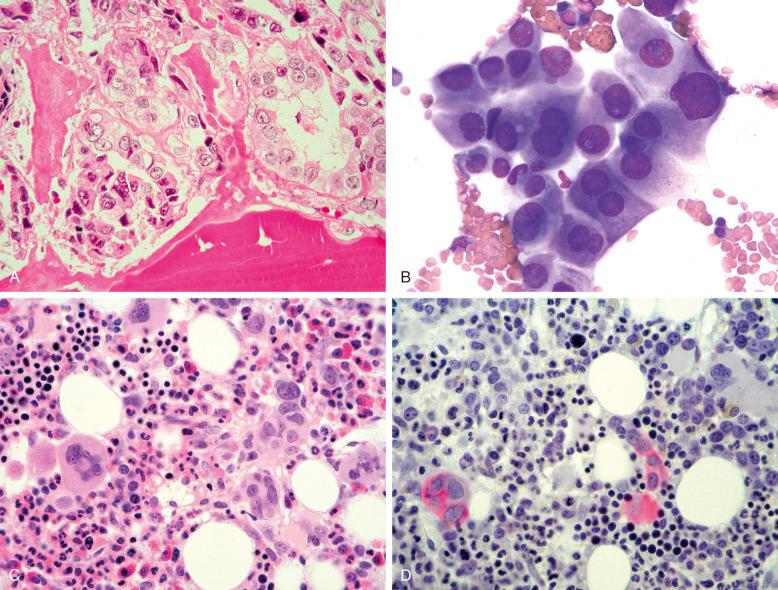
Carcinoma of the lung involves the bone marrow with frequency also varying by histologic type. Small-cell carcinoma (SCC) most frequently metastasizes to the bone marrow (~20%), followed by squamous cell carcinoma (3% to 15%) and adenocarcinoma (5% to 10%).
In SCC, tumor cells resemble blasts but with frequent clustering and nuclear molding ( Fig. 58-3 ). They label for pan-keratins, CK7, chromogranin, and synaptophysin. Patients frequently exhibit neuroendocrine syndromes. Carcinoid tumors may also rarely metastasize to the bone marrow.
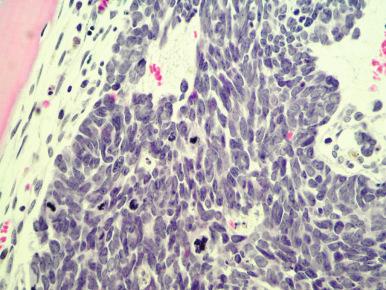
Squamous cell carcinoma is distinctive in the bone marrow biopsy but usually does not appear in aspirates, which may be acellular. Nests of cohesive tumor cells label for pankeratins, CK7, CK5/6, and p63 and are often imbedded in a fibrous background.
Adenocarcinomas ( Fig. 58-4 ) are increasingly common in the lung and label for pan-keratins, CK7, napsin A, and TTF-1. A recent international classification system includes lepidic, acinar, solid, papillary, micropapillary, and solid types, and several variants. Molecular and/or IHC determinations of EGFR, KRAS, and ALK status are clinically indicated for assignment of targeted therapy, usually from a primary site. Detection in metastatic sites may be performed by IHC or FISH, but there is significant intratumor variability with metastases often not reflecting the primary site.
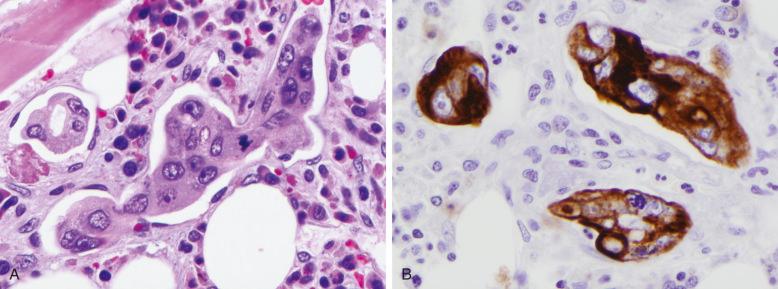
Metastatic prostate cancer most commonly involves bone marrow. Although primary prostate tumors are frequently well-differentiated adenocarcinomas with small acinar formation, it is the less well-differentiated forms that tend to metastasize, particularly moderately differentiated forms with fused glands, cribriform or papillary formations, or with absence of apparent gland formation ( Fig. 58-5 ). Often the diagnosis is suggested by serum screening for prostate-specific antigen (PSA) and confirmed by prostate biopsy, but it also appears as bone involvement by adenocarcinoma of unknown primary origin. Immunohistochemistry is usually positive for (PSA), prostatic acid phosphatase (PAP), and pan-keratins. Poorly differentiated tumors negative for PSA and PAP may label for prostate-specific membrane antigen (PSMA) and prostein (P501S). Study of microenvironmental features are leading toward targeted therapies.
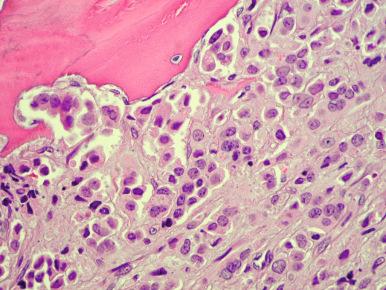
Most carcinomas of the stomach are adenocarcinomas with intestinal and diffuse types and papillary, tubular, mucinous, signet ring, adenosquamous, small-cell, and other variants. Immunohistochemistry shows pan-keratins, EMA, CEA, CK20, CK7, and CA19-9. A lymphoepithelioma-like pattern with abundant lymphocytes may also be seen.
Most colorectal carcinomas are moderately differentiated adenocarcinomas ( Fig. 58-6 ). These tumors label for cytokeratins (typically positive for CK20 but negative for CK7), CEA, villin, CDX2, and tumor-associated glycoprotein (TAG-72). A small-cell variant labels with NSE and synaptophysin. IHC and RT-PCR for CK20 and other tumor markers to identify micrometastases are emerging as prognostic determinants.
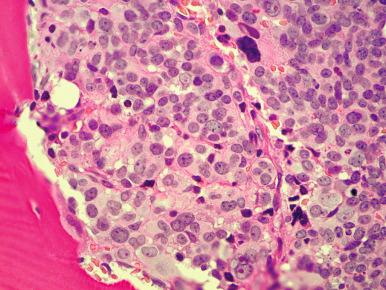
Renal cell carcinoma (RCC) often involves bone in advanced stage, occurring in one third of RCC patients enrolled in clinical trials. Bisphosphonates have been used for treatment but may be supplanted by new targeted agents. IHC should include pan-keratins, CD10, RCC, PAX2, and PAX8.
Become a Clinical Tree membership for Full access and enjoy Unlimited articles
If you are a member. Log in here